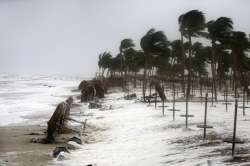A cyclone more powerful than any previously recorded in southern Oman slammed into the Gulf country and neighbouring Yemen on Saturday, deluging a major city with nearly three years’ worth of rainfall in a single day. The storm killed at least six people while more than 30 remain missing, officials said. According to reports, Yemen's fisheries minister Fahad Kafin has confirmed that casualties of the storm include two Indians.
However, four Indian sailors who had been declared missing were found alive by rescue teams.
Cyclone Mekunu caused flash flooding that tore away whole roadways and submerged others in Salalah, Oman’s third-largest city, stranding drivers. Strong winds knocked over street lights and tore away roofing.
Rushing waters from the rain and storm surge flooded typically dry creek beds. The holiday destination’s now-empty tourist beaches were littered with debris and foam from the churning Arabian Sea.
Three people, including a 12-year-old girl, died in Oman, and another two bodies were recovered from the Yemeni island of Socotra. More than 30 people were still missing in Socotra, including Yemeni, Indian and Sudanese nationals.
Yemeni officials also reported damage in the country’s far east, along the border with Oman. Rageh Bakrit, the governor of al-Mahra province, said on his official Twitter account late Friday that strong winds had blown down houses and taken out communication lines and water services. He said there were no fatalities in the province.
India’s Meteorological Department said the storm packed maximum sustained winds of 170-180 kilometres (105-111 miles) per hour with gusts of up to 200 kph (124 mph). It called the cyclone “extremely severe.”
Portions of Salalah, home to some 200,000 people, lost power as the cyclone made landfall.
Branches and leaves littered the streets. Several underpasses became standing lakes. Some cars were left abandoned on the road. Electrical workers began trying to repair lines in the city while police and soldiers in SUVs patrolled the streets. On the outskirts of the city, near the Salalah International Airport, what once was a dry creek bed had become a raging river.
The airport, closed since Thursday, will reopen early Sunday, Oman’s Public Authority for Civil Aviation said. The Port of Salalah — a key gateway for the country and for Qatar amid a regional diplomatic dispute — remained closed, its cranes secured against the pounding rain and winds.
Omani forecasters said Salalah and the surrounding area would get at least 200 millimetres (7.87 inches) of rain, over twice the city’s annual downfall. It actually received 278.2 mm, nearly three times its annual rainfall.
Authorities remained worried about flash flooding in the area’s valleys and potential mudslides down its nearby cloud-shrouded mountains. In nearby Wadi Darbat, the storm’s rains supercharged its famous waterfall.
Police and others continued their rescue efforts even as the winds and rains calmed. Capt. Tarek al-Shanfari of the Royal Oman Police’s public relations department said there had been at least three fatalities in the storm, including the death of a 12-year-old girl who was hit in the head by a door flung open by the wind.
An Asian labourer died in a flooded valley and an Omani national in a 4x4 died when his vehicle was swept away, al-Shanfari said. Oman’s National Committee for Civil Defense announced a fourth death early Sunday, without offering details.
On Socotra, authorities relocated over 230 families to sturdier buildings and other areas, including those more inland and in the island’s mountains, Yemeni security officials said.
Flash floods engulfed Socotra’s streets, cutting electricity and communication lines. Some humanitarian aid from Saudi Arabia and the United Arab Emirates arrived on the island just hours after the cyclone receded.
An Omani civil defence staff visits a road which has been cut by the flood water after Cyclone Merkunu in Salalah on Saturday.
Yemeni security officials said rescuers recovered two bodies on Socotra, while more than 30 people remain missing. They spoke on condition of anonymity because they were not authorized to brief reporters.
The island, listed by UNESCO as a World Heritage Site, has been the focus of a dispute between the UAE and Yemen’s internationally recognized government, which are ostensibly allied against Shiite rebels known as Houthis.
Socotra has a unique ecosystem and is home to plants, snails and reptiles that can be found nowhere else.
In Oman, Mohammed Omer Baomer warned his neighbours about a torn-away chunk of the road just down the street from his home after earlier getting his SUV stuck over it.
“It was a scary feeling, as if it was the end of world,” he said of the cyclone. “You can’t even go outside. You try to watch from the window and you can’t.”
Yet even as Mekunu barreled overhead, the eye of the storm provided a moment’s respite early Saturday morning. At one luxury hotel in Salalah, which already had evacuated its guests, workers sat down early for “suhoor,” a meal Muslims eat before sunrise during the holy fasting month of Ramadan. They laughed and shared plates by flashlight in a darkened ballroom, the cyclone’s wind a dull roar behind their clatter.
(With inputs from AP)
Latest World News
